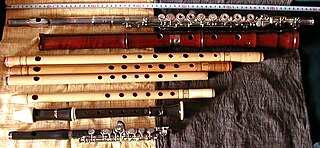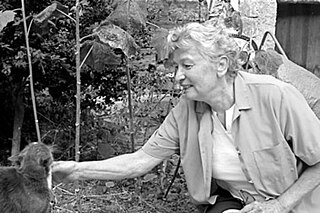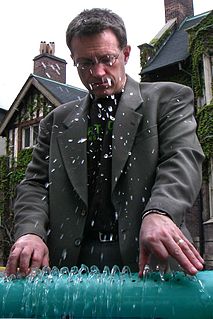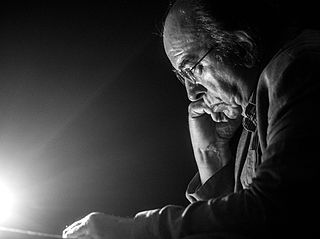
The kora is a string instrument used extensively in West Africa. A kora typically has 21 strings, which are played by plucking with the fingers. It combines features of the lute and harp.
Musique concrète is a type of music composition that utilizes recorded sounds as raw material. Sounds are often modified through the application of audio effects and tape manipulation techniques, and may be assembled into a form of montage. It can feature sounds derived from recordings of musical instruments, the human voice, and the natural environment as well as those created using synthesizers and computer-based digital signal processing. Compositions in this idiom are not restricted to the normal musical rules of melody, harmony, rhythm, metre, and so on. It exploits acousmatic listening, meaning sound identities can often be intentionally obscured or appear unconnected to their source cause.

Pierre Henri Marie Schaeffer was a French composer, writer, broadcaster, engineer, musicologist and acoustician. His innovative work in both the sciences—particularly communications and acoustics—and the various arts of music, literature and radio presentation after the end of World War II, as well as his anti-nuclear activism and cultural criticism garnered him widespread recognition in his lifetime.

An aerophone is a musical instrument that produces sound primarily by causing a body of air to vibrate, without the use of strings or membranes, and without the vibration of the instrument itself adding considerably to the sound.

The Baschet Brothers were two French artists named François Baschet and Bernard Baschet who collaborated on creating sound sculptures and inventing musical instruments, such as the Cristal Baschet. François Baschet was a sculptor and Bernard Baschet an engineer. The Baschet Brothers invented the inflatable guitar, the aluminum piano and many other experimental musical instruments. They created an "Baschet Educational Instrumentarium" for exposing young people to musical concepts.

The gravikord is a modern, 24 string, electric double bridge-harp invented by Robert Grawi in 1986, which is closely related to both the West African kora and the kalimba. It was designed to employ a separated double tonal array structure making it possible to easily play cross-rhythms in a polyrhythmic musical style in a modern electro-acoustic instrument. There is a similar instrument, also developed by Grawi, the gravi-kora, which is tuned identically to a traditional 21 string African kora.

Éliane Radigue is a French electronic music composer. She began working in the 1950s and her first compositions were presented in the late 1960s. Until 2000 her work was almost exclusively created with the ARP 2500 modular synthesizer and tape. Since 2001 she has composed mainly for acoustic instruments.
Experimental Musical Instruments was a periodical edited and published by Bart Hopkin, an instrument builder and writer about 20th century experimental music design and custom made instrument construction. Though no longer in print, back issues are still available. The material and approach of EMI can now be found electronically on their site hosted by Bart Hopkin. This site is, together with www.oddmusic.com the main source on the internet for experimental musical instrumentalism.

An experimental musical instrument is a musical instrument that modifies or extends an existing instrument or class of instruments, or defines or creates a new class of instrument. Some are created through simple modifications, such as cracked drum cymbals or metal objects inserted between piano strings in a prepared piano. Some experimental instruments are created from household items like a homemade mute for brass instruments such as bathtub plugs. Other experimental instruments are created from electronic spare parts, or by mixing acoustic instruments with electric components.

Jean-Claude Éloy is a French composer of instrumental, vocal and electroacoustic music.

The Savart wheel is an acoustical device named after the French physicist Félix Savart (1791–1841), which was originally conceived and developed by the English scientist Robert Hooke (1635–1703).
Jean-Jacques Birgé is an independent French musician and filmmaker, at once music composer, film director, multimedia author, sound designer, founder of record label GRRR. Specialist of the relations between sound and pictures, he has been one of the early synthesizer players and home studio creators in France in 1973, and with Un d.m.i. the initiator of the return of silent movies with live orchestra in 1976. His records show the use of samplers since 1980 and computers since 1985.
Music without sound can refer to music that falls outside the range of human hearing or to compositions, such as visual music, that are analogous to or suggestive of conventional music but in media other than sound, such as color, shape, position, motion and literature. It is commonly taken for granted that music is wont to be performed or recorded, but some sound works simply won't fit on a disc or on stage, being either extremely discreet or incomplete. Additionally, silence can be regarded as the via negativa of music and has induced long lasting fascination to music composers of all kinds. A composer deals with the absence of sound as much as they deal with sounds. Therefore, this article includes several examples of apophasis in music.
It seems to me that the most radical redefinition of music would be one that defines 'music' without reference to sound.
Robert Ashley, 1961.
The whirly tube, corrugaphone, or bloogle resonator, also sold as Free-Ka in the 1960s-1970s, is an experimental musical instrument which consists of a corrugated (ribbed) plastic tube or hose, open at both ends and possibly wider at one end (bell), the thinner of which is rotated in a circle to play. It may be a few feet long and about a few inches wide. The faster the toy is swung the higher the pitch of the note it produces, and it produces discrete notes in the harmonic series like a valveless brass instrument, but the fundamental and second harmonic are difficult to excite. To be played in concert the length of the tube must be trimmed to tune it. Hornbostel–Sachs number: 412.22, the tube is a whirling non-idiophonic (reedless) interruptive free aerophone, but is usually included in the percussion section with sound effects such as chains, clappers, and thunder sheets.

André Almuró was a French radio producer, composer, and film director.

Jacques Burtin is a French composer, writer, producer and filmmaker.
Bart Hopkin is a builder of experimental musical instruments and a writer and publisher on the subject. Hopkin runs the website windworld.com, which provides resources regarding unusual instruments.
The Studio d'Essai, later Club d'Essai, was founded in 1942 by Pierre Schaeffer, played a role in the activities of the French resistance during World War II, and later became a center of musical activity.
French electronic music, a panorama of French music that employs electronic musical instruments and electronic music technology in its production.

Marc Honegger was a French musicologist and choirmaster.













